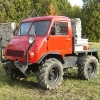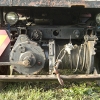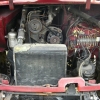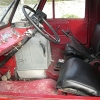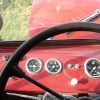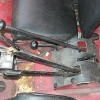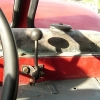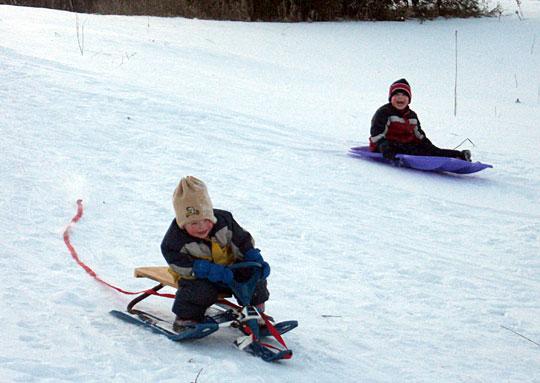
Happiness defined
Gil and Declan tobogganing.

Gil and Declan tobogganing.
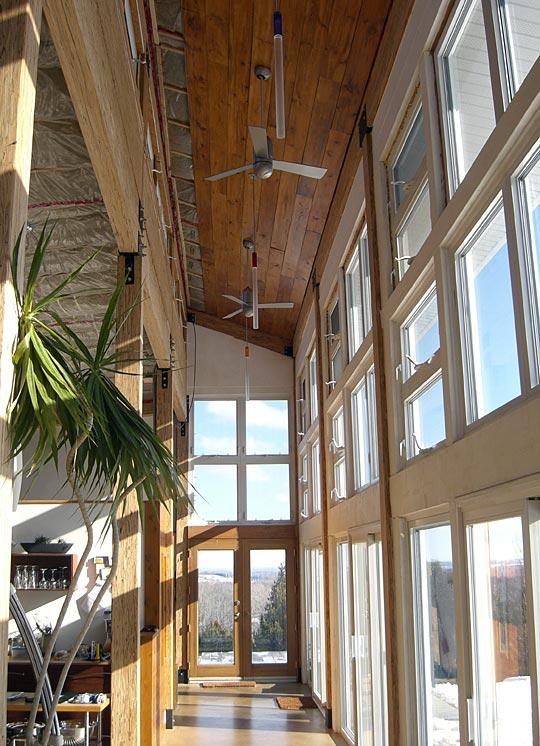
Over the Christmas holiday’s we started covering the ceiling in the gallery space with tongue and groove cedar. Dad won the cedar at an auction last spring for a very good price. We won a large stack of boards almost all of which were 16’ long, 8” wide and all were tongue and grooved. Unfortunately about 40% of the boards were in pretty bad shape: worm-eaten, weathered, rotten, or warped in some way. We’ve been cladding our various sheds in the crappier boards and putting aside the good ones to use inside. This fall Joanne and Mom sanded and finished some of those good boards and that’s what we’ve been using.
Over time the Tuck tape that sticks the vapour barrier to the beams has lost it’s tack so I’m re-taping as I go.
Fitting the long boards is much easier with a helper. By the end of a day working over your head like this your arms feel like they are about to drop right off.
For extra fun every board in the middle row had to be custom cut to accommodate the light and fan junction boxes. Also because the boards need to be staggered the scaffolding had to make the full trip back and forth across the gallery about a half-dozen times over the course of the project.
We didn’t have quite enough boards so we’ll complete the job in the spring when we can finish the boards outside - the stain that we use for colour really reeks.
As usual when Dad works so do the children. What’s remarkable about this picture is that Gil is actually hammering real nails, into real wood with a toy plastic hammer. No I don’t know why there is a parking lot beside the board. Look at how long those legs are! Wonder where he gets his build from?
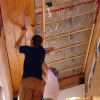
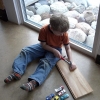

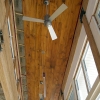
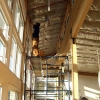
Kara over at Stonehouse Straw House has an interesting post up now on a terrible experience they’ve been having with their exterior finish and their interesting (and very nice) solution. They used earthen plasters on their outside walls and under prolonged exposure to some pretty extreme rain the plaster actually started to slough off. Earthen plasters have been around for a long time but in my experience they’re mostly used in the southern (read: dryer) states. Despite this some folks have started using them in Ontario, and apparently the maritimes. Earthen plasters are very nice looking, easy (though very labour intensive) to apply, and have little of the health/environmental baggage that accompanies regular lime plasters such as we used. My suggestion, if you like earthen plasters is that you use them on interior walls, and stick to the tougher lime plasters for the exterior.
What I really like about the post though is their solution. They created a board and batten exterior wall that covers and shields the damaged plaster while still allowing for airflow. In the end the solution ends up being just as attractive, if not more so, than the original wall. Bravo!

As often happens around here it’s been quite a while since my last post, so I figured I’d upload some pictures to give a sense of some recent events around here.
We finished of the deck on the east side of the house with some steel grating we acquired a year or so ago. Near the back part of the house we built a sandbox for the kids. When they’re grown we’ll make a nice zen garden or something back there.
Joanne has been busy finishing the ash boards that will be going up on the ceiling. We figure that we have enough for the whole front half of the house. The scaffolding is out on loan right now, but comes back in a week or so, this will be a late summer job for us, but it will be fantastic to have a ceiling up.
Most blog readers beyond friends and family won’t know this but we lost both of our dogs in the last 12 months. Ceara had a stroke and had to be put down last May, she was 14 1/2. Gator had a tumour on his spine, we had to put him down in February. Gator made it to 11, which if you were familiar with his tendency to eat foreign objects was a miracle. We were devastated. The picture above is Cash. He’s our new boy, a 3 year-old Chesapeake Bay Retriever. The boys are head over heals in love with him. Fortunately he has shown no inclination to eat rocks.
Sometimes I can’t believe how lucky I am to have ended up here with such a fantastic family and place to live. Sometimes the universe concurs.

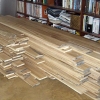
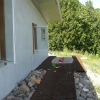
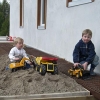
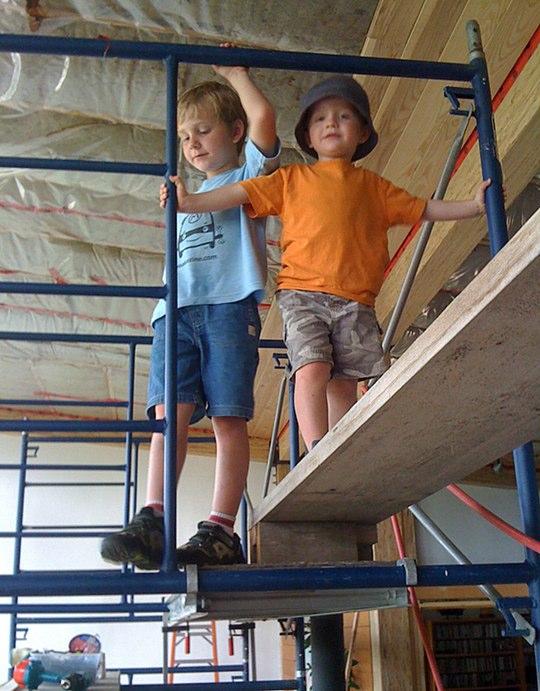
We’ve been making some excellent progress on the ceiling. It’s rough work handling the hardwood boards up over your head, I can only manage about 4 hours at a time before I’m done. For the back section we’ll mill the boards thinner, we don’t need a full 5/8” for a ceiling, 1/2” would work out just fine.
Luckily we’ve been getting some help from friends and family. Phil and his boys made a trip up and we got a big section done, Stephen came by and lent a hand, and of course Dad’s been a rock.
Every board has to have each end squared up with the chop saw and all of the end boards have to be custom cut to fit. Joanne has become a master with the saw, tape and square.
We’re about two thirds done and might even be ready for trim in a few weeks.
Of course the boys wouldn’t mind if the job lasts a while longer, after all most kids don’t have a jungle gym in their living room.
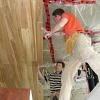
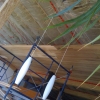
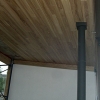
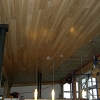
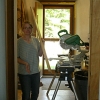
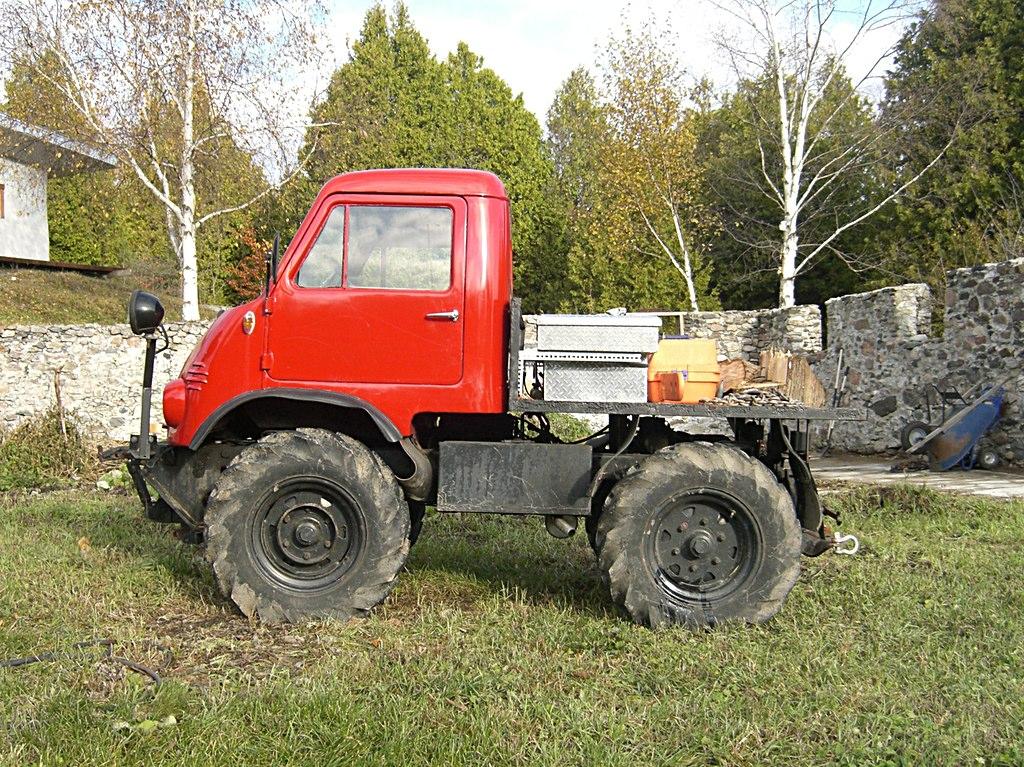
We’ve known for a while that our work horse ‘93 Nissan Pathfinder was approaching the end of it’s useful life. The exhaust system is wrecked, the brakes leak, and it isn’t capable of getting into the gnarlier parts of our property. It was useful for logging out the edges of the forest, but it’s both too big and not capable enough to make it into some of the more dense bush on the property. We’d have to invest thousands of dollars in repairs, tires, and a winch to make it useful again. So about a year ago we started researching various vehicles looking for a multi-use vehicle that could help us with logging, plowing our driveway, lowering our wind turbine, and collecting maple sap (yes, we’re making maple syrup this spring). We looked at full and mid-size pickups, 4 wheelers, side-by-sides, and then I stumbled upon Unimogs.
One year later we have purchased a 1953 Unimog 401 hard-top. It has a 25hp diesel engine, a 7500/lb winch and a snowplow. The machine is 10’ long, 7’ wide, and 7’ tall without the plow. The plow adds nearly 3’ to the length. The gearing on the Unimog is very low, in 1st gear it has a top speed under 5 km/h, 2nd takes you to nearly 10 km/h. Its top speed is about 50 km/h in 6th gear downhill with a tail-wind. With it’s big agricultural tires, massive ground clearance and low gearing we’ve been able to get to parts of the land that were completely inaccessible except by foot.
The lights are on stalks so they can project over the plow. The large black box between the wheels holds the battery.
On the front you can see the hydraulics for the plow. The round grated part inside the front hub is meant to be a step. Not surprisingly these ‘mogs are often called “frog eyed”.
We added a truck box for storage. The wedges are used as wheel chocks when using the winch.
The winch is an original Werner, 7500/lb winch driven by the PTO. The wrench is our lever, up is forward, middle is neutral, down is brake. It has ~ 50’ of 7/16” steel cable on it but we’ve ordered 100’ of 7/16” synthetic winch rope. It’s stronger and safer than the cable. We’ll be having a fair-lead custom made to fit the drum.
It’s an OM636 Mercedes diesel engine producing 25hp. Despite how cramped the engine compartment looks it’s quite easy to work on. Needs a good dose of degreaser.
The cabin is a tight fit to say the least. I can just barely get my legs under the steering wheel. The seats are all the way back but the machine is very easy to drive, though it’s loud, hot and very noisy.
Key on for power, move lever left for glow plug, wait, move lever left again to start. Oil pressure, engine temp, mystery switch, windshield wipers, headlights, speedometer, and another mystery switch.
From top to bottom: Forward/Neutral/Reverse lever, gear shift lever, PTO engage lever, emergency brake, 2WD/4WD/4WD lock hubs lever. Reverse only works in 1st and 2nd gear. 3rd gear is the start of high range, 4th - 6th are only accessible from 3rd. Below the levers you can see the plow hydraulic controls.
The hand throttle allows you to set engine revs without using the foot pedal, it’s mostly used for setting an idle speed and controlling the take-up speed for the winch. Yes, that’s the coolant reservoir up on the dash.
